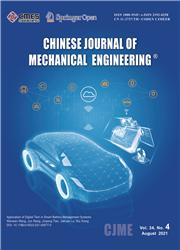基于fft的非线性弹性接触数值方法
IF 4.5
2区 工程技术
Q1 Engineering
引用次数: 1
摘要
在有关密封的理论研究中,必须使用接触模型来获得泄漏通道。然而,对于弹塑性接触,现有的数值方法需要较长的计算时间。超弹性接触通常被简化为线性弹性接触问题,其计算精度有待提高。基于快速傅里叶变换,提出了一种适用于弹塑性和超弹性无摩擦接触的数值方法,可用于求解二维和三维接触问题。将非线性弹性接触问题转化为考虑残余变形(或等效残余变形)的线性弹性接触问题。将半球与刚性平面之间的弹性、弹塑性和超弹性接触的数值模拟结果与有限元法的数值模拟结果进行了比较,验证了数值方法的准确性。与现有弹塑性接触数值方法相比,该方法在保证一定计算精度的同时,计算效率更高(即在64 × 64网格下,压力误差不超过15%,计算时间不超过10 min)。对于超弹性接触,所提出的方法减少了近似结果对载荷的依赖,就像在线性弹性近似中一样。最后,以密封应用为例,计算了复杂三维粗糙表面之间的接触率和泄漏率。尽管存在一定的误差,但简化的数值方法得到的近似结果优于线弹性接触近似。此外,该结果可作为工程应用中的快速解决方案。本文章由计算机程序翻译,如有差异,请以英文原文为准。
FFT-Based Numerical Method for Nonlinear Elastic Contact
Abstract In theoretical research pertaining to sealing, a contact model must be used to obtain the leakage channel. However, for elastoplastic contact, current numerical methods require a long calculation time. Hyperelastic contact is typically simplified to a linear elastic contact problem, which must be improved in terms of calculation accuracy. Based on the fast Fourier transform, a numerical method suitable for elastoplastic and hyperelastic frictionless contact that can be used for solving two-dimensional and three-dimensional (3D) contact problems is proposed herein. The nonlinear elastic contact problem is converted into a linear elastic contact problem considering residual deformation (or the equivalent residual deformation). Results from numerical simulations for elastic, elastoplastic, and hyperelastic contact between a hemisphere and a rigid plane are compared with those obtained using the finite element method to verify the accuracy of the numerical method. Compared with the existing elastoplastic contact numerical methods, the proposed method achieves a higher calculation efficiency while ensuring a certain calculation accuracy (i.e., the pressure error does not exceed 15%, whereas the calculation time does not exceed 10 min in a 64 × 64 grid). For hyperelastic contact, the proposed method reduces the dependence of the approximation result on the load, as in a linear elastic approximation. Finally, using the sealing application as an example, the contact and leakage rates between complicated 3D rough surfaces are calculated. Despite a certain error, the simplified numerical method yields a better approximation result than the linear elastic contact approximation. Additionally, the result can be used as fast solutions in engineering applications.
求助全文
通过发布文献求助,成功后即可免费获取论文全文。
去求助
来源期刊

Chinese Journal of Mechanical Engineering
ENGINEERING, MECHANICAL-
CiteScore
5.60
自引率
4.80%
发文量
3097
审稿时长
8 months
期刊介绍:
Chinese Journal of Mechanical Engineering (CJME) was launched in 1988. It is a peer-reviewed journal under the govern of China Association for Science and Technology (CAST) and sponsored by Chinese Mechanical Engineering Society (CMES).
The publishing scopes of CJME follow with:
Mechanism and Robotics, including but not limited to
-- Innovative Mechanism Design
-- Mechanical Transmission
-- Robot Structure Design and Control
-- Applications for Robotics (e.g., Industrial Robot, Medical Robot, Service Robot…)
-- Tri-Co Robotics
Intelligent Manufacturing Technology, including but not limited to
-- Innovative Industrial Design
-- Intelligent Machining Process
-- Artificial Intelligence
-- Micro- and Nano-manufacturing
-- Material Increasing Manufacturing
-- Intelligent Monitoring Technology
-- Machine Fault Diagnostics and Prognostics
Advanced Transportation Equipment, including but not limited to
-- New Energy Vehicle Technology
-- Unmanned Vehicle
-- Advanced Rail Transportation
-- Intelligent Transport System
Ocean Engineering Equipment, including but not limited to
--Equipment for Deep-sea Exploration
-- Autonomous Underwater Vehicle
Smart Material, including but not limited to
--Special Metal Functional Materials
--Advanced Composite Materials
--Material Forming Technology.
 求助内容:
求助内容: 应助结果提醒方式:
应助结果提醒方式:


